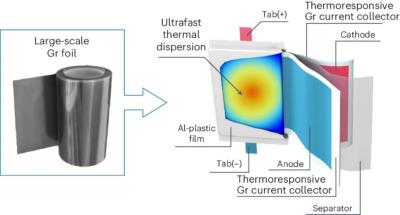Researchers at Swansea University, in collaboration with China's Wuhan University of Technology and Shenzhen University, have developed a technique for producing large-scale graphene current collectors that could significantly enhance the safety and performance of lithium-ion batteries (LIBs).
Their recent study details the first successful protocol for fabricating defect-free graphene foils on a commercial scale. These foils offer excellent thermal conductivity - nearly ten times higher than traditional copper and aluminium current collectors used in LIBs.
The scientists explain that their method allows for the production of graphene current collectors at a scale and quality that can be readily integrated into commercial battery manufacturing, which not only improves battery safety by efficiently managing heat but also enhances energy density and longevity.
One of the most pressing concerns in the development of high-energy LIBs, especially those used in electric vehicles, is thermal runaway - a dangerous process where excessive heat leads to battery failure, often resulting in fires or explosions. The newly-designed graphene current collectors are meant to mitigate this risk by efficiently dissipating heat and preventing the exothermic reactions that lead to thermal runaway.
The team stated that the dense, aligned graphene structure provides a robust barrier against the formation of flammable gases and prevents oxygen from permeating the battery cells, which is crucial for avoiding catastrophic failures.
The newly developed process is said to be a scalable solution, capable of producing graphene foils in lengths ranging from meters to kilometers.
In a demonstration of its potential, the researchers produced a 200-meter-long graphene foil with a thickness of 17 micrometers.
This foil retained high electrical conductivity even after being bent over 100,000 times, making it ideal for use in flexible electronics and other advanced applications.
This new approach also allows for the production of graphene foils with customizable thicknesses, which could lead to even more efficient and safer batteries.
The team will be working to refine the process, with ongoing efforts to reduce the thickness of the graphene foils and further enhance their mechanical properties, also exploring this new material beyond Li-ion batteries, such as redox flow batteries and sodium-ion batteries.


